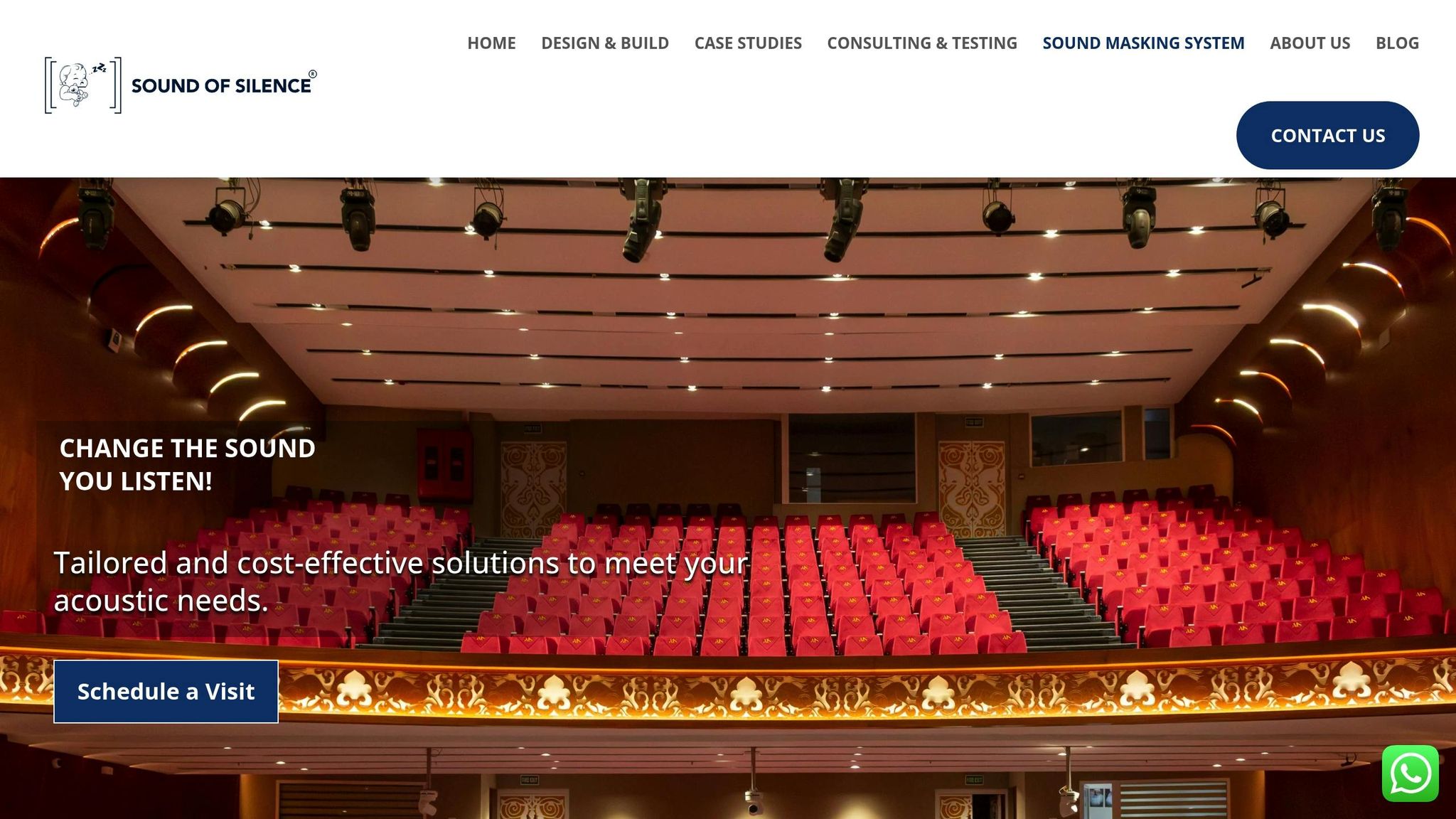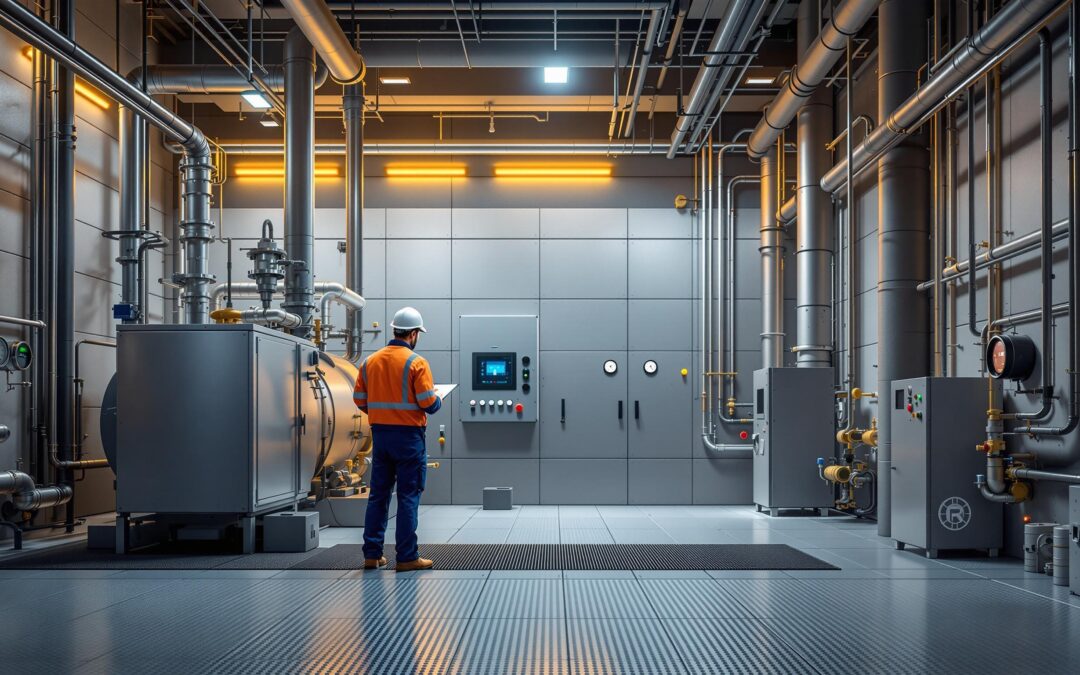Boiler rooms in power plants can be dangerously noisy, exceeding safe limits and causing hearing damage, stress, and equipment wear. Soundproofing is the solution. Here’s how you can tackle the problem:
- Understand Noise Sources: Boilers, pumps, and ventilation systems generate distinct types of noise.
- Measure Noise Levels: Use proper testing tools to identify noise hotspots and problematic frequencies.
- Choose the Right Materials: Use acoustic panels, mineral wool, and anti-vibration mounts to absorb and block noise.
- Install Barriers and Seals: Fit acoustic doors, wall treatments, and duct silencers to stop sound leakage.
- Monitor and Maintain: Regular checks and replacements ensure long-term effectiveness.
Soundproofing improves safety, boosts equipment lifespan, and ensures compliance with regulations like the Control of Noise at Work Regulations 2005. Start with acoustic testing, implement tailored solutions, and keep systems in top shape with regular maintenance.
Boiler Room Soundproofing
Noise Analysis and Measurement
Effective soundproofing begins with identifying noise sources and measuring sound levels to address specific problem areas.
Main Noise Sources
In boiler rooms, common noise sources include steam boilers, feed pumps, and ventilation systems. Each of these produces different types of noise, requiring tailored approaches. For instance, the low-frequency noise from steam boilers demands a different solution compared to the noise generated by feed pumps or ventilation systems.
Noise Level Testing
Acoustic testing involves three key steps:
-
Initial Assessment
Measure sound levels at critical locations, such as near equipment and operator workstations. Testing devices must meet BS EN 61672-1:2013 standards to ensure reliable results. -
Frequency Analysis
Use spectrum analysis to identify specific frequencies that need treatment. Tools like detailed sound maps help pinpoint problem areas with precision. -
Vibration Testing
Focus on areas such as equipment mounts, wall-floor connections, pipe joints, and structural supports to detect vibration-related noise.
Testing should take place during peak operational hours to capture the highest noise levels. Regular monitoring ensures the effectiveness of soundproofing measures and helps detect new issues early. These detailed measurements guide the selection of appropriate materials and methods for soundproofing, which are explored in the next section.
Soundproofing Materials and Methods
Once you’ve identified and measured noise sources, the next step is choosing the right materials and techniques to address them.
Sound-Absorbing Materials
Acoustic panels and insulation are key to reducing noise. Materials like mineral wool panels, glass fibre insulation, and melamine foam are effective, particularly in industrial environments. Ensure the materials you choose comply with fire safety and temperature standards.
Vibration Control
Reducing vibration is just as important as sound absorption. Anti-vibration mounts designed for specific equipment loads can minimise vibration transfer. Inertia bases and flexible connectors at pipe joints or ductwork connections can further dampen vibrations. Make it a point to inspect these components regularly to maintain their effectiveness.
Noise Barriers and Seals
To prevent sound from escaping, use sturdy noise barriers. Opt for acoustic doors with high sound transmission ratings and apply multi-layer wall treatments using dense materials and sealants. Duct silencers are also useful for balancing noise reduction with maintaining airflow. Incorporate all these elements into a comprehensive acoustic plan that addresses both direct and flanking sound paths. Routine monitoring and maintenance will ensure these systems continue to perform well over time.
sbb-itb-06ab728
Installation Guide
Preparing the Site
Before starting the installation, clear the area of any debris and ensure all surfaces are clean and dry. Perform an acoustic assessment to pinpoint areas needing treatment and establish baseline noise levels. Check all mounting surfaces to ensure they can properly support the soundproofing materials. Pay special attention to sealing pipe penetrations, ductwork, and electrical conduits.
Steps for Installing Materials
Begin with vibration control components, as these are crucial to the soundproofing system. Install anti-vibration mounts and inertia bases according to the manufacturer’s guidelines, ensuring the load is evenly distributed. Place panels with consistent spacing for optimal results.
When treating walls, start at the corners and work methodically across the surfaces. Fit acoustic doors with tight seals, using materials specifically designed for soundproofing. After completing the installation, move on to performance testing.
Testing System Performance
Measure sound levels inside and outside the boiler room after installation, comparing them to the initial baseline levels. Conduct these tests during peak operational hours to ensure the system’s effectiveness.
Sound of Silence offers acoustic testing services, including:
- Sound pressure level measurements
- Vibration analysis
- Reverberation time evaluations
- Detection of any remaining weak points
If the tests show areas needing improvement, make the necessary adjustments to achieve the desired noise reduction. Regular checks are important to keep the system performing at its best over time.
Maintenance Requirements
After installation, keeping the system in good working order requires consistent inspections and timely adjustments.
Regular Inspections
Check soundproofing systems on a routine basis to ensure they continue to work as intended. During these inspections, look at panels, isolators, seals, and treated surfaces. Pay extra attention to areas exposed to high temperatures or moisture, and note any signs of wear or damage.
Replacing Materials
If inspections reveal wear or a drop in performance, replace the affected soundproofing materials. Keep track of installation dates and set replacement schedules to ensure everything remains effective. Pair these efforts with ongoing noise monitoring for the best results.
Noise Monitoring
Use calibrated equipment to regularly measure noise levels and compare them to the original baseline. This helps identify any performance issues early. If needed, Sound of Silence’s acoustic specialists can assist with setting up monitoring systems, conducting professional assessments, and recommending maintenance actions.
Consistent maintenance and active monitoring are essential for keeping soundproofing systems effective in boiler room environments.
Summary
Main Steps Review
Start by analysing noise levels to pinpoint primary sound sources and establish baseline measurements. Next, choose the right sound-absorbing materials, incorporate vibration control measures, and install noise barriers with proper sealing.
Prepare the site by cleaning surfaces and checking mounting points. Ensure materials are installed in areas exposed to high temperatures and moisture, and test their effectiveness regularly. Follow up with performance verification through testing.
To maintain effectiveness over time, conduct regular inspections and promptly replace any worn materials.
Sound of Silence Solutions

Sound of Silence provides specialised acoustic solutions for industrial settings, including power plant boiler rooms. Their approach covers every stage of the process:
| Service Phase | Components |
|---|---|
| Initial Assessment | Acoustic testing, vibration analysis, and identifying noise sources |
| Design | Creating tailored soundproofing plans, selecting materials, and strategies |
| Implementation | Professional installation, quality checks, and verifying performance |
| Ongoing Support | Regular monitoring, maintenance advice, and system adjustments |
Their industrial acoustics team offers expert guidance throughout the project, ensuring effective noise reduction without disrupting operations. These customised solutions help power plants significantly reduce noise while adhering to workplace safety and environmental standards.

